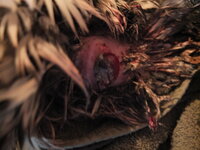I have a medical question that I'm hoping someone can advise me on.
This is Corazon, who experienced a major prolapsed vent on Sunday. I managed to get most of it back in at the time. She's crated on her own, eating, drinking and in good spirits. I'm given her calcium rich foods, clipped the feathers around her vent, cleaned her vent and applied an astringent daily.
My concern is her vent seems to have lost its elasticity, so although the prolapse is much better her vent is not able to totally hold it in.
Last year I dealt with an egg bound hen when the egg was actually stuck partway out her vent. I was able to break and extricate it, but she was left with a permanently distended vent which meant she dribbled poop all the time and was vulnerable to infection like Salpingitis or flystrike.
Can anyone suggest what I can do to help her vent tighten up and go back to normal? Will it ever get better or once stretched that much, even briefly, is she going to end up with a floppy vent?
I've heard of people who loosely sew the vent edges together, but I don't see that as a solution.
The photos were taken Sunday, Monday and today - there is improvement in the prolapse, but her vent hasn't gotten better.



This is Corazon, who experienced a major prolapsed vent on Sunday. I managed to get most of it back in at the time. She's crated on her own, eating, drinking and in good spirits. I'm given her calcium rich foods, clipped the feathers around her vent, cleaned her vent and applied an astringent daily.
My concern is her vent seems to have lost its elasticity, so although the prolapse is much better her vent is not able to totally hold it in.
Last year I dealt with an egg bound hen when the egg was actually stuck partway out her vent. I was able to break and extricate it, but she was left with a permanently distended vent which meant she dribbled poop all the time and was vulnerable to infection like Salpingitis or flystrike.
Can anyone suggest what I can do to help her vent tighten up and go back to normal? Will it ever get better or once stretched that much, even briefly, is she going to end up with a floppy vent?
I've heard of people who loosely sew the vent edges together, but I don't see that as a solution.
The photos were taken Sunday, Monday and today - there is improvement in the prolapse, but her vent hasn't gotten better.



 The ready made powder should not be heated as I explained. It would probably work, only slower than fresh off the tree.
The ready made powder should not be heated as I explained. It would probably work, only slower than fresh off the tree.